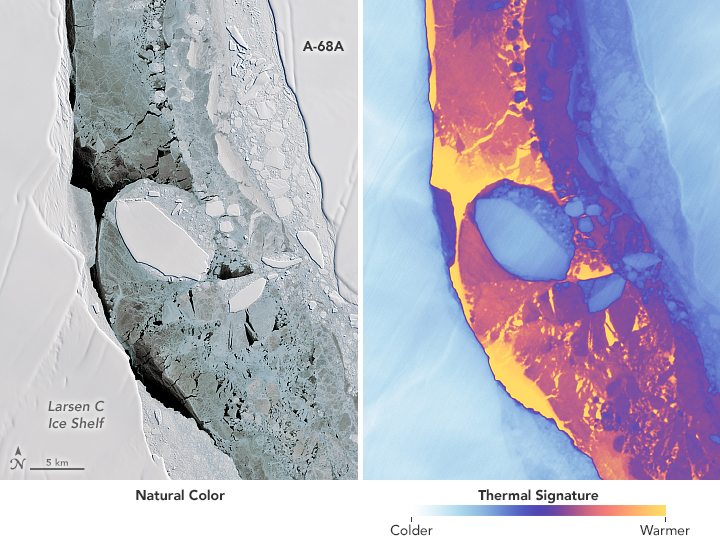Massive Iceberg A-68 adrift after emerging from polar night
Meteorologist/Science Writer
Tuesday, October 3, 2017, 5:06 PM - New satellite images from NASA reveal immense Iceberg A-68 now adrift among Antarctic sea ice, after splitting off from the Larsen C ice shelf back in July.
When a PEI-sized iceberg sheared away from one of Antarctica's largest ice shelves, thus becoming one of the largest icebergs ever seen, the southern polar region was in the depths of winter darkness. While certain satellite views - namely the ones that produce images based on temperature rather than visible light - allowed us to track the progress of the fissure that caused A-68 to split off, and showed us exactly when the iceberg officially formed, we were unable to get a really good look at it.

Comparison between Iceberg A68 and Prince Edward Island, from July 12, 2017. Credit: NASA Worldview/Google/Scott Sutherland
Since the region emerged from polar night in September, NASA's satellites have been snapping daily images of A-68, showing both the main iceberg A-68A and the small chunk that split off from the northern tip, A-68B.

Icebergs A-68A and A-68B, imaged by Landsat-8 on Sept 16, 2017. Visible light image on the left. False-colour thermal image on the right. Credit: NASA/Landsat/Joshua Stevens
According to NASA Earth Observatory:
The image on the left shows the icebergs in natural color. The rifts on the main berg and ice shelf stand out, while clouds on the east side cast a shadow on the berg. The thermal image on the right shows the same area in false-color. Note that the clouds over the ice shelf do not show up as well in the thermal image because they are about the same temperature as the shelf. Thermal imagery has the advantage of showing where the colder ice ends and “warm” water of the Weddell Sea begins. It also indicates differences in the thickness of ice types. For example, the mélange is thicker (has a colder signal) than the frazil ice, but thinner (warmer signal) than the shelf and icebergs.
After initially rocking back and forth in the cavity it formed at the end of Larsen C, A-68 has since drifted away from the ice shelf, with the gap in between being filled with mélange - smaller chunks of ice that broke off from the edges of A-68A and the face of the ice shelf, mixed with sea ice that slipped in as the larger iceberg moved farther out.

An animation of the progress of A-68A and A-68B, since they emerged from polar night. Credit: NASA/Aqua MODIS/Scott Sutherland
The primary reason for A-68 drifting away from Larsen C is apparently winds blowing off the ice shelf, which forced sea ice farther into the Welland Sea, opening up an area for A-68 to move into. The motion of the iceberg, after this, will depend on how the sea ice moves and melts as the south polar region progresses into spring.
![]() RELATED: Did Iceberg A-68 break away due to climate change?
RELATED: Did Iceberg A-68 break away due to climate change?
The large iceberg floating free in the gap between A-68A and Larsen C, visible in the animation above, is not large enough to earn its own name, but it is quite significant, nonetheless.

The gap between A-68A and Larsen C, in visible (left) and thermal (right) imagery. Credit: NASA/Landsat/Joshua Stevens
Although there is little doubt that this iceberg originated from the calving of A-68, its edges are much crisper and more angular, when compared to A-68A itself. As noted in the NASA Earth Observatory story, this is due the larger iceberg's edges being worn down by wind and gravity, while the smaller iceberg has been carved by numerous collisions.
Watch for more updates on Iceberg A-68 as they come in.
Source: NASA Earth Observatory | NASA Visible Earth



